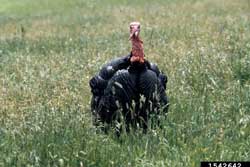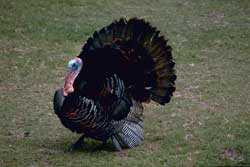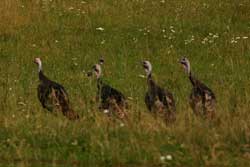Home → → Other Critters → Wild Turkey
Wild Turkey—Meleagris gallopavo
The wild turkey was a very important food animal to Native Americans, but it was eliminated from much of its range by the early 1900s by hunting and loss of habitat. Introduction programs have successfully established it in most of its original range. Turkeys are omnivores–they eat acorns, nuts, seeds, fruits, buds, berries, flowers, insects, snails, slugs, worms, small frogs and salamanders. They feed during the day and roost in trees at night.
Wild turkeys travel in small flocks. Because of their large numbers they can become pests by digging in lawns and gardens, where they also leave large numbers of droppings; by stopping traffic by congregating in roads; and by pecking and scratching at cars and other reflective surfaces. They are beneficial because of the many pests they eat, including insects, slugs, and snails. They are protected by law.

Wild turkeys are covered with dark feathers that help them blend in with their woodland homes. The bare skin on the throat and head can change color from flat gray to striking shades of red, white, and blue when the bird becomes distressed or excited.
Click on images to view full-size
Identification and Control Information
- Wildlife in Connecticut: Wild Turkey (PDF)—Connecticut Department of Environmental Protection
- Eastern Wild Turkey Fact Sheet—Vermont Fish & Wildlife
- Prevent Conflicts With Turkeys—Massachusetts Division of Fisheries & Wildlife
- Fact Sheet with Management Options (PDF)—Cornell Cooperative Extension
[Photos, left to right: Alfred Viola, Northeastern University, Bugwood.org; Gary M. Stolz, US Fish and Wildlife Service, Bugwood.org; Paul Bolstad, University of Minnesota, Bugwood.org]

